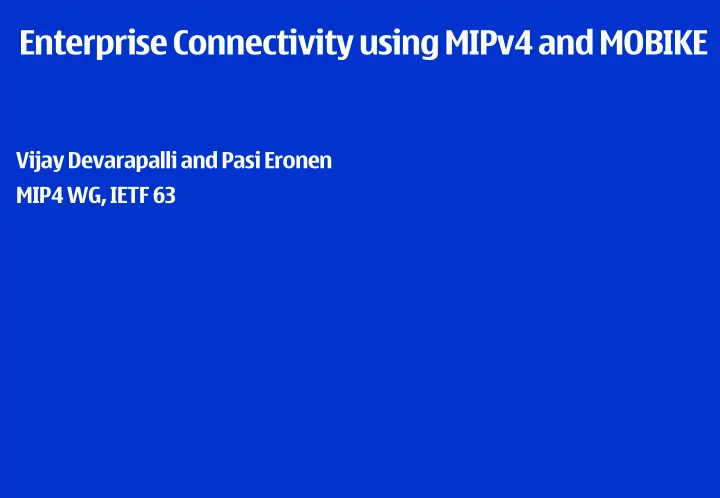

Enterprise Connectivity using MIPv4 and MOBIKE Vijay Devarapalli and Pasi Eronen MIP4 WG, IETF 63
Enterprise connectivity • Enterprise networks • A typical enterprise networks has users connecting from trusted and untrusted networks • The trusted and untrusted networks are separated by a DMZ • Access to the intranet is controlled by a firewall and VPN gateway in the DMZ • Tools to enable secure connectivity and mobility for enterprise users • IPsec VPNs • Mobile IPv4 • Mobility extensions to IKEv2 (MOBIKE)
Available Solutions • draft-ietf-mip4-vpn-problem-solution-01 • Describes how MIPv4 and IPsec VPNs can be used together • Uses dual MIP due to many reasons • Non IPsec VPNs • IPsec VPNs that don’t survive MN movements • IKEv1 based IPsec VPNs • Our proposal • If MOBIKE supported, use it • Eliminates the need for one MIP4 tunnel and the external Home Agent • Three access modes • ‘f’ – MIP with FA-CoA • ‘c’ – MIP with CCoA • ‘mc’ – mobile enhanced VPN with VPN_TIA as the CCoA
MN inside the Enterprise network • The MN uses regular MIPv4 for subnet mobility • Traffic does not go through the DMZ • Confidentiality protection maybe required between the MN and the FA/access router, if the MN uses a wireless link to connect to the trusted network
MN outside the Enterprise • MN has an IPsec VPN tunnel with the VPN GW in the DMZ • If the MN moves, it uses the MOBIKE protocol to update the tunnel end point at the VPN GW • MN also has a binding cache at the HA • The MN uses the VPN Tunnel Inner Address (TIA) as the CCoA for MIP registration • If the VPN TIA changes, the MN must send a registration request to update the binding at the HA • If the MN connects to a new VPN GW, the MN must send a registration request to update the binding at the HA
Crossing Security Boundaries • Based on the reachability of the HA from the MN’s current point of attachment • Whenever the MN moves, it sends a Registration Request to the HA without VPN encapsulation • If the HA responds, then the MN is inside the enterprise network • Otherwise, it is not • The MN at the same time also contacts the VPN GW • If a VPN tunnel already exists, the MN sends a MOBIKE message message • If a VPN tunnel doesn’t exist already, the MN sends a IKEv2 message to setup a VPN tunnel • If the VPN GW responds and the HA does not, the MN is outside the enterprise • More details in the draft
An Optimization • Send agent discovery message and DHCP request message at the same time • This avoids the delay involved in first discovering if there is an FA available and then performing DHCP • Some implementations already do this • Recommend this for all mobile node implementations; should be configurable to turn it off
NAT Traversal • MIP4 NAT traversal should be used if there is a NAT between the MN and the HA • IPsec NAT traversal should be used if there is a NAT between the MN and the VPN GW • If VPN TIA is from a private address space associated with the VPN GW, then both MIPv4 and IPsec NAT traversal should be used together in the access mode, ‘mc’
Recommend
More recommend